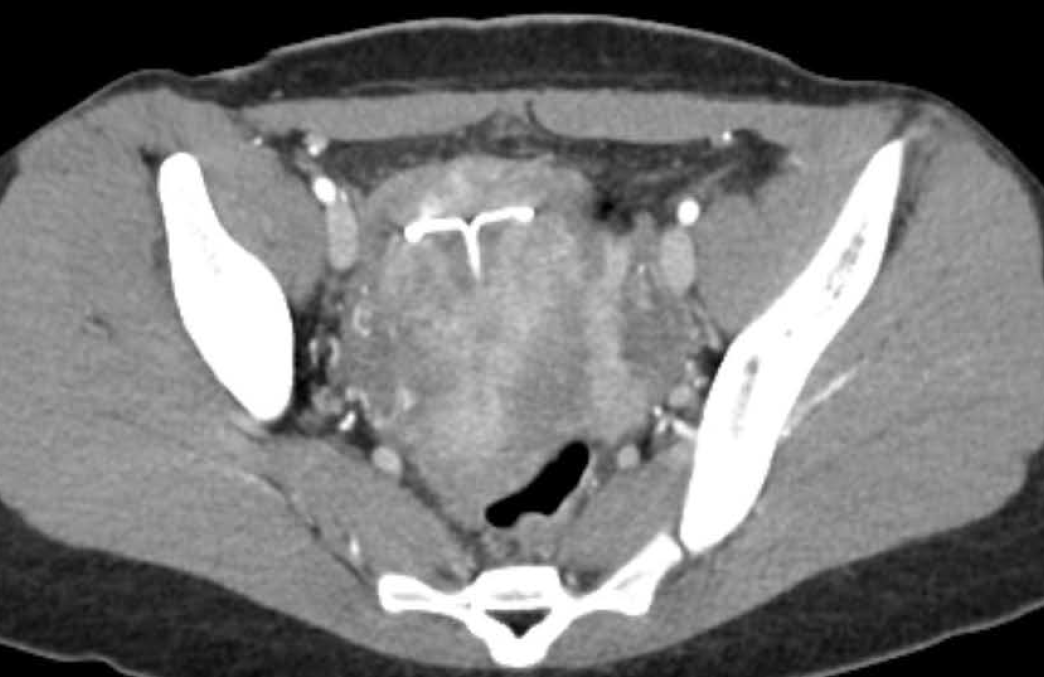A 23 y.o. woman presents with R sided abdominal pain
What is wrong with her liver?
And do you notice anything in the pelvis?
Our patient had Fitz-Hugh-Curtis syndrome. This is a complication of PID which leads to liver capsule inflammation and adhesions. It was named after Thomas Fitz-Hugh and Arthur Curtis who reported the syndrome in 1934 and 1930 when they evaluated patients with pelvic infections.
The syndrome is characterized by RUQ pain and often very little pelvic pain. Adhesions are seen on laparoscopy and often cervical cultures are positive for chlamydia or gonorrhea. Our patient was positive for chlamydia.
these adhesions are best diagnosed on laparoscopy but as in our case hepatic inflammation can sometimes be seen
Which brings up an interesting question: How often are women with PID misdiagnosed as UTI? Our patient had received Keflex for a UTI on the day prior to arrival at an urgent care.
Urinalysis can be positive in either UTI or STIs. A culture would be the gold standard for diagnosing UTI or pyelonephritis with a negative culture excluding the disease. PID on the other hand is diagnosed by identifying a purulent cervical discharge, a friable , reddened cervix; and cervical motion tenderness on pelvic exam since cultures can be negative in the presence of disease.
Since the rates of infection with Chlamydia and Neisseria are highest among sexually active girls aged 15- 19, the rate of PID is highest in this group. In one study of sexually active adolescent girls and young women aged 14-22 with urinary symptoms; 20% had UTI only, 30% had STI only and 9% had both. Others in the study had herpes, bacterial vaginosis and candida. The study supports the recommendation that young women be evaluated for both UTI and STI with an “in person” visit since untreated STIs can lead to permanent infertility. In older women a study by Shapiro suggests 57% of patients with dysuria had a UTI and 17% had an STI.
It is hard to guess based on symptoms whether an STI is present
Our patient was seen by gyne, discharged on two weeks of doxycycline, but returned at a later date with lightheadedness and bruising on the extremities. She has persistent RUQ pain. Her platelets were normal.
Peter N, Clark L, Jaeger J. Fitz-Hugh—Curtis syndrome: a diagnosis to consider in women with right upper quadrant pain. 2004. Cleveland Clinic Journal of Medicine 71(3):233-239.
Curtis A. A cause of adhesions in the right upper quadrant JAMA 1930 94(16):1221-2.
Huppert J, Biro F, Lan D et al. Urinary symptoms in adolescent females: STI or UTI? Adolesc Health. 2007;40: 418-424.
Kimball P, Newby P, Vinci R. Adolescent female with urinary tract symptoms: a diagnostic challenge for the pediatrician.Pediatric Emergency Care 2011. 27(9):789-794.
Shapiro T, Dalton M, Hammond J, et al. The prevalence of urinary tract infections and sexually transmitted disease in women with symptoms of a simple urinary tract infection stratified by low colony count criteria. Acad Emerg Med 2005;12:38-44.



